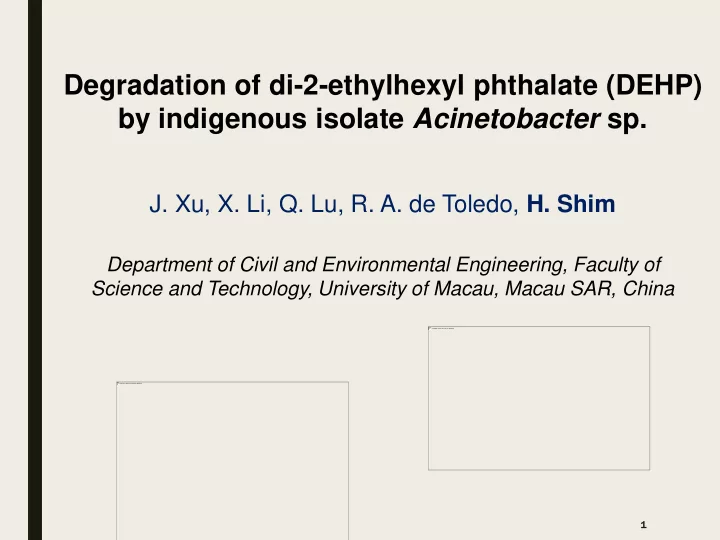

Degradation of di-2-ethylhexyl phthalate (DEHP) by indigenous isolate Acinetobacter sp. J. Xu, X. Li, Q. Lu, R. A. de Toledo, H. Shim Department of Civil and Environmental Engineering, Faculty of Science and Technology, University of Macau, Macau SAR, China 1
BACKGROUND Phthalate esters (PAEs) Used as plasticizers Endocrine disrupting chemicals (EDCs) Physically (rather than chemically) bonded to the plastic matrix O O O O O O O O O O O O Di (2-ethylhexyl) phthalate Butyl Benzyl phthalate Dimethyl phthalate (DEHP) (BBP) (DMP) O O Di (2-propylhexyl) phthalate O (DPHP) O O O O Diisobutyl phatalate 2 (DIBP) O
BACKGROUND Di(2-ethylhexyl) phthalate (DEHP) One of the most cost effective and widely available general purpose plasticizers PVC, toys, and medical devices Dysfunction of endocrine, reproductive, and nervous systems Possible human carcinogen since 1987 (USEPA) DEHP concentration in (waste)water in China (Wang et al., 2011) Standard industrial well water pond water drinking Contaminant wastewater ( μg /L) ( μg /L) water ( μg /L) ( μg /L) DEHP 42.4 14.2 135.7 8 Wang et al., 2011. Environ. Sci. Pollut. Res. 18, 987-996 3
BACKGROUND Physicochemical processes Adsorption, Membrane filtration, Advanced oxidation processes (AOPs) No mineralization Generation of by-products Not cost effective Biological process Anaerobic and aerobic conditions Environmentally friendly Cost effective Contaminant mineralization No research about the effects of microelements (inhibitory/stimulatory) on PAEs biodegradation 4
OBJECTIVES To remove DEHP from artificially contaminated water using indigenous bacterial isolate, Acinetobacter sp. To optimize the DEHP biodegradation process To evaluate growth kinetics and biodegradation pathway for DEHP by the isolate To evaluate the effects of microelements (Fe 3+ and Mn 2+ ) on DEHP biodegradation 5
MATERIALS AND METHODS Microbial isolation Activated sludge samples from wastewater treatment plant (Macau SAR, China) Enrichment Enriched in nutrient broth (3 g l -1 beef extract + 5 g l -1 peptone) Cultured in a basal salt medium (BSM) with increasing DEHP concentration (from 10 to 500 mg l -1 ) as sole carbon source Microbial identification 16S rRNA gene sequence analysis Sequences deposited in NCBI GenBank under the accession number KX_670538 6
MATERIALS AND METHODS Experimental setup Temperature, pH, and microelements Inoculum (5 ml) BSM solution (45 ml) spiked with 100 mg l -1 DEHP Temperatures (25 C, 30 C, 35 C) pHs (3, 5, 7, 8, 9) Microelements Fe 3+ and Mn 2+ (100, 500, 1,000 μg l -1 ) Kinetic studies: Initial DEHP concentrations (10-500 mg l -1 ) at pH 7.0 ± 0.2 and 30 C. Treatments incubated in the dark at 150 rpm and 30 ºC, in replicates DEHP concentrations and OD 600 were determined in every 24 h for 5 days One-way analysis of variance (ANOVA) at the 95% confidence interval 7
MATERIALS AND METHODS Analytical methods DEHP concentration: HPLC/DAD (Thermo Fisher Scientific, USA) Column: AcclaimTM C18 (5 m, 4.6 x 150 mm), temperature 45 ℃ Mobile phase: acetonitrile:deionized water (9:1), flow rate 0.5 ml min -1 - Linearity:10 to 500 mg l -1 (n=3), r 2 0.9977 - Precision (100 mg l -1 ): Repeatability (n=6), 0.51% Intermediate precision (d=6), 1.35% Accuracy (100 mg l -1 ): 100.4 1.67% spike-recovery - Biodegradation pathway: HPLC-MS (Thermo Fisher Scientific, USA) Electrospray ionization (ESI) source Probe temperature: 300 ℃ Polarity: positive Optical density: UV mini-1240 spectrophotometer (Shimadzu, Japan) 8
RESULTS Microorganism identification == == Phylogenetic tree for the isolate Acinetobacter sp. 9
RESULTS Effects of temperature and pH There was no significant difference in DEHP biodegradation: 35 C and 30 C (p=0.22) pH 6-9 (p=0.87) Neutral pH is also considered optimal for the growth of other Acinetobacter spp. Effects of temperature (a) and pH (b) on DEHP biodegradation 10 10
RESULTS Biodegradation kinetics Substrate inhibition kinetics: Biodegradation kinetics parameters for the isolate Acinetobacter sp. grown on DEHP Parameter Degradation rate Specific growth rate D max (mg/L•day) 124.8 - µ max (day -1 ) - 0.1192 K s (mg/L) 272.3 137.6 K i (mg/L) 720.5 850.3 11 11
RESULTS DEHP biodegradation and cell growth (B) (A) DEHP biodegradation (A) and cell growth (B) at different initial concentrations: (- -) 500; (- -) 400; (- -) 300; (- -) 200; and (- -) 100 mg/L 12 12
RESULTS Effects of microelements DEHP removal efficiencies after the addition of (a) Fe 3+ and (b) Mn 2+ at different concentrations 13 13
RESULTS Intermediates identification by HPLC-MS Mass spectra of DEHP (a), MEHP (b), β -carboxy- cis , cis -muconic acid (c), 3-katoadipate (d), and di-ethyl hexanoic acid (e) 14 14
RESULTS DEHP biodegradation pathway Proposed DEHP biodegradation pathway for the isolate 15 15
CONCLUSIONS The optimal temperature for the biodegradation is considered 30 ºC and the neutral and alkaline conditions are shown favourable for DEHP degradation by Acinetobacter sp. SN13. High concentrations of DEHP (500 mg/L) were inhibitory to both biodegradation and cell growth. Ferric ion at 100-1,000 μg l -1 showed the stimulatory effect on the DEHP biodegradation, while Mn 2+ was stimulatory at the lower concentration (100 μg l -1 ) but inhibitory at higher concentrations (500-1,000 µg l -1 ). The biodegradation pathway for DEHP by the isolate is proposed with some metabolic products identified. The biological process could be further scaled up and applied to treat different types of wastewater, especially the ones containing high concentration levels of DEHP and other PAEs generated from the plastics industries. 16 16
ACKNOWLEDGEMENTS University of Macau Multi-Year Research Grant (MYRG2014-00112-FST) Macau Science and Technology Development Fund (FDCT 061/2013/A2 and FDCT 063/2013/A2 ) 17 17
Recommend
More recommend